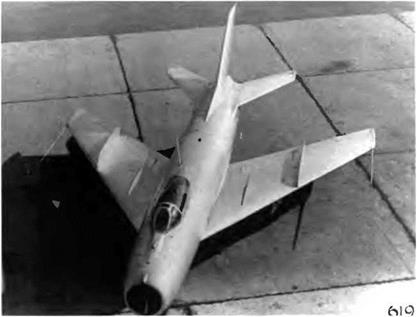1-370,1-380, 1410, and 1-420 Series
1-370 /1-1 /1-2
During the first half of the 1950s the ОКБ carried out—concurrently with the difficult development of the MiG-19—research work in other directions in its quest to break the sound barrier. One result was the I- 370 (prototypes 1-1 and 1-2), forefather of a new family of fighters that did not rely on Mikulin engines. The 1-370 represented a synthesis of the MiG-17 and MiG-19 as far as structure and aerodynamic design were concerned. Powered by a Klimov VK-7 but retaining the cannon arrangement of the MiG-17 (one N-37 on the right and two NR-23s on the left), the 1-1 borrowed the planform and 55-degree С/4 sweepback of the MiG-19 wing as well as the forward fuselage (except for a few modifications made necessary by the new power plant). The wing, attached to the fuselage just like the MiG-19, was of the monospar type with inside stiffeners.
The axis of rotation of the variable incidence stabilizer (with elevators) was just above the afterburner duct. Preliminary sketches showed the stabilizer atop the fin, but after the SM-2 tests it was put under the base. Because one VK-7 "inhaled" a lot less air than two AM-9Bs, the air intake section was reduced. To counterbalance the diminution in yaw stability, two ventral fins angled at 45 degrees were added under the tail. The ailerons and flaps were identical to those of the MiG-19.
|
As a synthesis of the MiG-17 and MiG-19, the 1-370 and its engine were developed in case of a setback to the MiG-19 program. |
The cockpit hood was molded in one piece with a frame member in elektron, a light magnesium alloy. In case of emergency it had to be jettisoned whatever the aircraft’s attitude. The windshield was bulletproofed and electrically heated. When the pilot activated the ejection seat, the cockpit hood was automatically jettisoned and the airbrakes were deployed.
The VK-7 no. K-733 had a nominal thrust of 3,455 daN (3,525 kg st) and 5,130 daN (5,235 kg st) with afterburner. In the midst of the flight tests it was replaced by a slightly more powerful VK-7 no. K-338 with 4,115 daN (4,200 kg st) of nominal thrust and 6,145 daN (6,270 kg st) with afterburner. At first the top speed of the 1-370 (1-1) reached 1,452 km/h (784 kt)—precisely that of the MiG-19S. But once the turbine inlet gas temperature was raised to 800° C (1,472′ F), the 1-370 reached 1,510-1,520 km/h (815-821 kt).
Rolled out in December 1954, the 1-І prototype was first piloted by F. I. Burtsev of the Nil WS on 16 February 1955. Tests continued until 2 June. According to Burtsev—who flew the aircraft thirteen times— the 1-1 reached Mach 1.334 and remained steady in flight Moreover, it handled just like the MiG-19 while taking off, climbing, descending, and landing.
|
|
The pickup of the VK-7 was not as good as that of the VK-1F But so long as the engine speed did not exceed 12,100 rpm, the VK-7 running was virtually identical to the VK-1F at all ratings The three fuselage tanks had a capacity of 2,025 1 (535 US gallons) The first two tanks were of the bladder type, while the third was made of welded AMTsAM alloy in the rear fuselage Two drop tanks could be attached under the wing The weapon system included the ASP-4N gunsight tied to the Radal-M ranging radar, the RSIU-3 VHF, IFF interrogator, and the OSP – 48 ILS receiver A new wing that featured a sweepback C/4 of 57 degrees did not help the aircraft reach its design airspeed With that new wing the aircraft was renamed the 1-2.
Specifications
Span, 9 m (29 ft 6.3 in), overall length 12 7 m (41 ft 8 in), fuselage length, 10 44 m (34 ft 3 in); wheel track 4 156 m (13 ft 7 6 in), wheel base, 4 508 m (14 ft 9 5 in); wmg area, 25 m2 (269 sq ft), empty weight, 5 086 kg (11,210 lb) takeoff weight 7,030 kg (15,495 lb) max takeoff weight, 8 300 kg (18 295 lb) fuel, 1 680 kg (3 700 lb) wmg loading, 280.2-332 kg/m2 (57.4-68 lb/sq ft)
Performance
Max speed, 1 452 km/h at 10 800 m (784 kt at 35,400 ft) climb to 5,000 m (16 400 ft) in 1 15 mm. to 10,000 m (32,800 ft) in 3 min service ceiling, 17 000 m (55,760 ft), approach speed 180 km/h (97 kt), takeoff roll, 464 m (1,522 ft); landing roll, 730 m (2,395 ft); range with two drop tanks, 2,500 km (1,550 mi)












